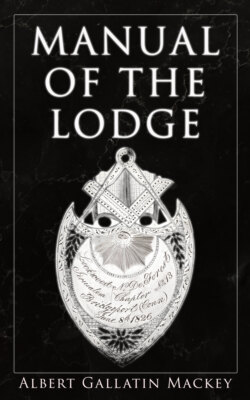Читать книгу Manual of the Lodge - Albert Gallatin Mackey - Страница 21
На сайте Литреса книга снята с продажи.
THE WORKING TOOLS.
ОглавлениеThe working tools of an Entered Apprentice are the Twenty-four-inch Guage and the Common Gavel.
The Twenty-four-inch Guage is an instrument used by operative masons to measure and lay cut their work; but we, as Free and Accepted Masons, are taught to make use of it for the more noble and glorious purpose of dividing our time. It being divided into twenty-four equal parts, is emblematical of the twenty-four hours of the day, which we are taught to divide into three equal parts; whereby are found eight hours for the service of God and a distressed worthy brother; eight for our usual vocations; and eight for refreshment and sleep. The Common Gavel is an instrument made use of by operative masons to break off the corners of rough stones, the better to fit them for the builder's use; but we, as Free and Accepted Masons, are taught to make use of it for the more noble and glorious purpose of divesting our hearts and consciences of all the vices and superfluities of life; thereby fitting our minds as living stones for that spiritual building, that house "not made with hands, eternal in the heavens."
This presentation of the working tools of a stone-mason to the candidate must necessarily attract his attention to the fact that there is a connection between the operative art and the speculative science, which connection simply consists in this, that speculative Masonry is the application and sanctification of the working tools and implements, the rules and principles of operative masonry, to the veneration of God and the purification of the heart.
The Operative Masons at Jerusalem, from whom we date our origin, were occupied in the construction of an earthly and material temple, to be dedicated to the service and worship of God—a house in which the mighty Jehovah was to dwell visibly by his Shekinah, and whence he was, by Urim and Thummin, to send forth his oracles for the government and direction of his chosen people.
The Speculative Mason is engaged in the construction of a spiritual temple in his heart, pure and spotless, fit for the dwelling-place of Him who is the author of purity; where God is to be worshiped in spirit and in truth, and whence every evil thought and unruly passion are to be banished, as the sinner and the Gentile were excluded from the sanctuary of the Jewish Temple.
In the symbolic language of Masonry, therefore, the twenty-four-inch guage is a symbol of time well employed; the common gavel, of the purification of the heart.
In the Ancient Mysteries, the first step taken by the candidate was a lustration or purification. The candidate was not permitted to enter the sacred vestibule, or to take any part in the secret formula of initiation, until by water or fire he was emblematically purified from the corruptions of the world which he was about to leave behind. A similar principle exists in Freemasonry where the first symbols presented to the Entered Apprentice are those which inculcate a purification of the heart, of which the purification of the body in the Ancient Mysteries was symbolic.
We no longer make use of the bath or the fountain, because in our philosophical system the symbolism is more abstract; but we present the candidate with the apron, the guage, and the gavel, as symbols, of a spiritual purification. The design is the same, but the mode in which it is accomplished is different.
In former times, before the general use of writing, men were accustomed to avail themselves of any imperishable substance, a memorial of some transaction, the record of which would now be committed to paper or parchment. Hence we find in the primitive Christian Church, that a fish-shaped die was used as a certificate of membership, and was so recognized from town to town and from church to church. Especially was a piece of metal or ivory made use of by the ancients as a token of a pledge of amity. Being broken into two pieces, the host, when he had entertained a stranger who was about to depart, gave the guest one part while he retained the other; and these broken pieces served in all times afterward as a memorial of the pledge of friendship that had been thus inaugurated. It may be that the Masonic custom of asking for the deposit of something of the kind in the Archives of the Lodge as a memorial, may have reference to this custom. The candidate is supposed to be thus giving his pledge of fidelity to the Institution. But the subsequent part of the ceremony would teach him that no material and tangible pledge is really wanted, but that the true pledge of Masonic friendship is deposited in the heart. At a future period, in the next section, an opportunity is taken to exemplify the practical application of the pledge thus made, by an impressive charge on the nature of charity.
